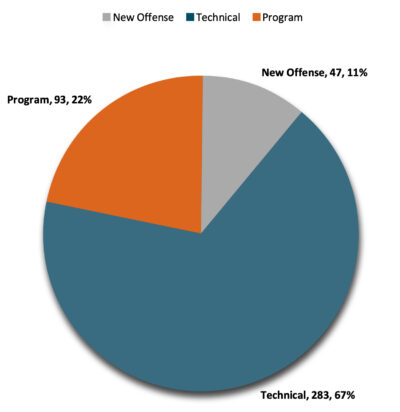
Criminal Justice in Delaware
With a 2020 population of 967,679 and a land area of just 1,982 square miles, Delaware is one of the smallest states in the U.S. by both population and geographic size.1,2 However, it is also one of the oldest populated areas in the U.S. and has a fully developed criminal justice system. This article summarizes that system.
Delaware Prison Population Statistics
One of the quickest ways to learn about a state’s criminal justice system is to examine its prison population, particularly the percentage of the overall population that is incarcerated. Delaware has the 17th highest incarceration rate in the United States, ahead of Alabama but behind Virginia.3
Delaware operates a ‘Unified Prison System,’ meaning its various forms of detention (jails, prisons, holding cells, migrant detention, etc.) are all combined into the same four incarceration facilities. Delaware is one of six states that utilize such a system, an efficient option for low-population states (the other five states with such a system are Alaska, Connecticut, Hawaii, Rhode Island, and Vermont).
Delaware incarcerates 3,735 individuals located in its state-run facilities.4 The Delaware Community Corrections System is also responsible for 13,010 individuals under probation and 362 under parole. The state employs 2,412 Department of Corrections staff with a budget of $328.4 million. The Department of Corrections is Delaware’s seventh costliest budget item.5
Delaware’s incarceration rate of 382 per 100,000 population is slightly lower than the U.S. average but slightly higher than most other states. Delaware’s violent crime rate is 423 per 100,000, and its property crime rate is 2,252 per 100,000.
As for its prison facilities, Delaware operates four carceral institutions within its territory, the largest of which is the James T. Vaughn Correctional Center, located near Smyrna, in New Castle County. The facility can house up to 2,500 inmates. Delaware does not have any federal or private prisons within its territory.6
Crime and Recidivism Rates in Delaware

Delaware records between 4,000 and 5,000 reported violent crimes each year, the majority of which are aggravated assault, robbery, or a combination of the two. The state reports about 30,000 property-related crimes each year.
Overall crime rates have gradually declined in Delaware since the early-2010s. Some years, like 2012 to 2013, saw as much as a 5%-7% annual drop in violent and property-related crime. Further, the state’s prison population has been declining slightly since 1999. The decline is very slow, but it is consistent.
However, recidivism rates in Delaware are surprisingly high. The state has a 67.3% recidivism rate, which means two out of three incarcerated individuals in the state will re-enter prison at some point after their release.7 Recidivism is such an issue of concern in Delaware that the state commissioned an in-depth research project to study the issue and determine why released prisoners are re-offending and ending up in prison again.8
The factors of a higher-than-average recidivism rate coupled with declining crime rates and prison population may seem contradictory. What it actually means is that fewer new people are committing crimes and thus entering the prison system. Rather, the same group of individuals is responsible for the lion’s share of crime and incarceration in Delaware, hence the high recidivism rate. A high recidivism rate suggests a state’s criminal rehabilitation programs could be improved.
Criminal Rehabilitation in Delaware
The criminal justice system in Delaware seeks to help reform and rehabilitate individuals who have committed crimes and who must be removed from society to protect public safety. The following are a few of the programs the state has organized to accomplish this:9
- Alternatives to Violence Project, a program that helps offenders understand the root causes of anger and violence.
- Parenting Classes, for those incarcerated who have children.
- Anger Management, for incarcerated individuals living with a mental illness that results in angry outbursts.
- Reflections, a 90-day program for those convicted of multiple DUI charges.
- Think Things Through, a curriculum designed to provide offenders with tools to manage risk factors for recidivism.
- Transitions, a treatment program for sexual offenders.
- HeadStart Home Program, an intensive, offender-run program with primary goals to promote a positive, productive identity, enhance positive self-image, develop high stages of moral reasoning, and finally, encourage positive thought processes, i.e., to replace erroneous thinking patterns that are linked to recidivism.
Alternatives to Incarceration in Delaware

One of the primary contributing factors to Delaware’s high recidivism rate is that 67% of offenders are re-offending based solely on technical probation violations. These could be as simple as failing to attend a probation meeting or even failing to receive a probation-related phone call at a certain time of the day. Any such technical violation could be grounds for re-arrest and re-incarceration. One alternative to incarceration in Delaware that would reduce the prison population significantly would be for lawmakers to change the laws regarding technical probation violations.
Beyond modifying public policy regarding how people are incarcerated in Delaware, the state should also implement educational programs inside prisons in Delaware. In addition to adding evidence-based rehabilitation programs inside prisons in Delaware, the state should also develop alternatives to prisons that prevent offenders from ever entering the incarceration system. If fewer offenders went to prison in the first place, and if those offenders who did go to prison received better care once inside prison, recidivism rates would likely decline.
Criminal Reform in Delaware Can Be Achieved
There are many ways to address criminal actions. To assume that locking people up is the only answer is quite limited. Educational courses like the Criminon program can help offenders understand why they committed the crime in the first place and help them move forward from there.
Sources:
- United States Census. “Delaware.” United States Census, 2022. census.gov
- worldpopulationreview. “How Big is Delaware?” World Population Review, 2022. worldpopulationreview.com
- BJS. “Prisoners in 2020 – Statistical Tables.” Bureau of Justice Statistics, 2020. bjs.ojp.gov
- NIC. “Delaware 2019.” National Institute of Corrections, 2019. nicic.gov
- Urban Policy. “Project Delaware.” Urban Policy Center, 2022. urban.org
- DOC. “James T. Vaughn Correctional Center.” Delaware Department of Corrections, 2022. doc.delaware.gov
- BJA. “Delaware.” Bureau of Justice Statistics, 2014. bjafactsheets.iir.com
- SAC. “Recidivism in Delaware.” Statistical Analysis Center, 2020. sac.delaware.gov
- DCRC. “DOC Rehabilitation Programs.” Delaware Department of Corrections, 2022. doc.delaware.gov
Related Articles
Criminal Justice Reform Extends Rights to Felons Who Have Served Their Sentences
For decades, voter enfranchisement or disenfranchisement for incarcerated and formerly incarcerated individuals has been debated. An estimated 4.6 million Americans are barred from voting due...
Read more >>
Gainful Employment a Critical Factor in Post-Incarceration Life
Recidivism is one of the most important aspects of the United States criminal justice system and easily the most studied metric. The National Institute of...
Read more >>
Success – E.R.
I really enjoyed this course because I was always under the impression that graphs and statistics could only be used in the business workplace. Now...
Read more >>
Success – K.J. – Lorton Virgina
Upon completing the communication course I have accomplished one of the biggest wins of my life. At one point in my life I thought that...
Read more >>





